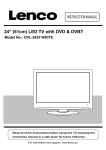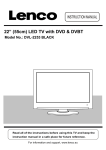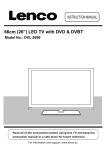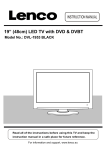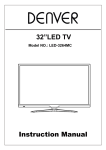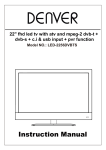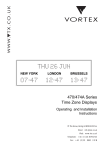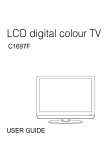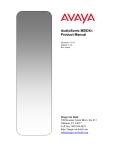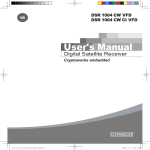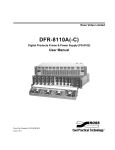Download Lenco LED-2213
Transcript
22” (55.5cm) Full HD LED TV WITH DVB-S Model No.: LED-2213 For information and support, www.lenco.eu Contents 1-3 SAFETY INFORMATION 4 5-6 7 8-11 12 13 14-21 Unit Remote Control Aerial connection Connecting external devices Auto installation setup Source menu Menu settings 21-35 DVBS Operation 36 37 TROUBLE SHOOTING GUIDE TECHNICAL SPECIFICATIONS options SAFETY INFORMATION IMPORTANT SAFETY INSTRUCTIONS - READ CAREFULLY BEFORE USE. Take note of the following safety information which appears on the back of the TV. CAUTION TO PREVENT ELECTRICAL SHOCK, DO NOT REMOVE ANY COVER SCREWS, NO USER SERVICEABLE PARTS INSIDE, REFER SERVICING TO QUALIFIED SERVICE PERSONNEL. This symbol indicates that there are important operating maintenance instructions in the literature accompanying this unit. This symbol indicates that dangerous voltage constituting a risk of electric shock is present within this unit. Keep these instructions • • • • • • • Do not use this TV near water. Clean only with a slightly damp cloth. Do not block any ventilation openings. Install in accordance with the supplied Quick Start Guide and this User Guide. Protect the power chord from being walked on or pinched, particularly at plugs, and the point where it exits from the TV. Do not allow the power chord to overhang the edge of a table. Unplug this TV during lightening storms or when unused for long periods of time. WARNING! TO REDUCE THE RISK OF FIRE OR ELECTRICAL SHOCK, DO NOT EXPOSE THIS TV TO RAIN OR MOISTURE. THE TV MUST NOT BE EXPOSED TO DRIPPING AND SPLASHING AND NO OBJECTS FILLED WITH LIQUIDS SHOULD BE PLACED ON THE TV. NOTE: No naked flames such as candles should be placed on the TV. 1 IMPORTANT SAFETY INFORMATION(Continued) This unit has been produced according to all current safety regulations. The following safety tips should safeguard users against careless use and the dangers connected with such use. x Although this appliance has been carefully manufactured and rigorously checked prior leaving the factory, as with all electrical appliances it is possible for problems to develop. If you notice smoke, an excessive build up of heat or any other unexpected phenomena, you should disconnect the plug from the mains power socket immediately. x Ensure that the unit is sufficiently ventilated! Never place next to or underneath curtains! x The mains plug or appliance coupler is used as the disconnect device, the disconnect device shall remain readily operarble. x This set should only be connected to a mains power supply which matches that stated on the label on the rear of the TV – do not attempt to connect it to any other type of supply. x The socket – outlet must be installed near the equipment and easily accessible. x To prevent overload, don’t share the same mains supply socket with too many other items of equipment. x Apparatus with Class 1 construction shall be connected to a mains socket outlet with a protective earthing connection. x Keep away from rodents. Rodents enjoy biting into electric flexes. x Always hold the plug when pulling out the plug from the mains supply socket. Do not pull on the flex, the flex can become overloaded and cause a short circuit. x Set up the unit so that no one is able to trip over the flex. x Do not place heavy items on the flex, which may damage it. x Take note that the flex cannot be reached and pulled by young children, avoiding injury. x Do not set up the unit near to heat sources. The casing and the flex could be damaged by the impact of heat. x The screen is made of plastic and can break if damage is done to it. Be careful when collecting sharp edged plastic splinters to avoid injury. x Avoid placing the unit on any surfaces that may be subject to vibrations or shocks. x To protect the unit during a thunderstorm unplug the AC power cable and disconnect the aerial. Caution: Do not touch the aerial (RF) connector. x When you leave your home for long periods of time, unplug the AC power cable for safety reasons. x The unit becomes warm when in operation. Do not place any covers or blankets on the unit in order to prevent overheating. The ventilation holes are not to be blocked. Do not set up near radiators. Do not place in direct sunshine. When placing on a shelf leave 5 cm (2”) free space around the whole unit. x Do not allow water or moisture to enter the TV. Do NOT use in wet or moist areas such as Bathrooms, steamy kitchens or near swimming pools. x Do not use this unit when moisture condensation may occur x Any repairs must be carried out by qualified personnel only. x Do not open this unit. A non – expert attempting to repair the unit could be dangerous and potentially cause a fire hazard. 2 IMPORTANT SAFETY INFORMATION (continued) Liquids spilt into the unit can cause serious damage. Switch the set OFF and disconnect the mains power supply, then consult a qualified service person before attempting to use the unit again. Do NOT remove the safety covers. There are no useable or serviceable parts inside. You may invalidate the warranty. Qualified personnel must only service this apperatus. Do NOT tap or shake the screen, you may damage the internal circuits. Take good care of the remote control, do not drop. Never place hot objects or open flame sources on or close to the TV. High temperatures can melt plastic and lead to fires. To clean the TV use a soft dry cloth. Do NOT use solvents or petrol based fluids. For stubborn stains, you may use a damp cloth with dilute detergent. Headphone Warning Loud music can damage your hearing irreversibly, therefore do not set the volume to a high level when listening through headphones, particularly for lengthy listening periods. Where to install Locate the television away from direct sunlight and strong lights, soft indirect lighting is recommended for comfortable viewing. Use curtains or blinds to prevent direct sunlight falling on the screen. Place the TV on a sturdy platform of which the surface should be flat and steady. This will prevent it from falling over. Make sure the television is located in a position where it cannot be pushed or hit by objects, as pressure will break or damage the screen, and so that small objects cannot be inserted into the ventilation slots or openings in the cabinet. 3 Unit and Accessories LED Indicator Remote Control Window (keep clear) The functions of the TV buttons are described below. MENU: Press to display the OSD menu, Press again to exit the menu. CH-/CH+: Press to scan through channels. They are also can be used to move down/up in the OSD menu screen. VOL-/VOL+: Press to adjust the volume. They are also can be used to move left/right in the OSD menu screen. VOL+ button can be used to skip forward to next menu. INPUT: Press to select the source. Power: Turn on/off the TV set. 4 Remote control POWER: Turn the TV on/standby. MENU INPUT Buttons for TELETEXT(In ATV mode) TV/TXT: Teletext on/off CANCEL: Turn off the Teletext display REVEAL: Reveal any hidden text, for example-quiz answer NICAM/A2 HOLD: Hold or carry on the current subpage SIZE: Press to see top half of page double size, Press again to see the bottom half of page double size, Press again for normal size SUBPAGE: press to subpage, again to cancel. INDEX: go to index. Colour buttons: short cuts-follow the coloured links in the text. (In DTV mode, press red key to switch between TV and radio. Green key, yellow key and blue key are invalid.) EXIT USB DISPLAY TV/RADIO DVBS-SAT DVBS-AUDIO DVBS-INFO FAV SUBTITLE TEXT PAUSE EPG PIC-FORMAT MENU : System setup menu. INPUT: Press to display the input source menu. CH+/- : Scan through channels. VOL+/- : Adjust the volume. Cursor left/right up/down : Cursor buttons used in menus. OK:CONFIRM BUTTON for menu. EXIT : Exit the OSD menu. USB: The short cuts to the multtimedia in DVBS mode. CH+/- : Scan through channels. VOL+/- : Adjust the volume. Cursor left/right up/down: Cursor buttons used in menus. OK:CONFIRM BUTTON for menu. 0-9,-/-Choose channel directly. Returns to the previous channel. 5 Remote control (continued) MENU INPUT EXIT USB DISPLAY TV/RADIO DVBS-SAT DVBS-AUDIO DVBS-INFO FAV SUBTITLE TEXT PAUSE EPG PIC-FORMAT PICTURE: Select the picture mode. SOUND: Select the sound mode. DISPLAY: Display current mode information. MUTE: Mutes the Audio. SLEEP: Standby Timer. TV/RADIO: Disc menu change between TV and Radio. DVBS-SAT: Display the satellite list. DVBS-AUDIO: Shows the list of available languages for the channel you are watching. DVBS-INFO: Shows information of the current channel. FAV: Display the favorite program list. SUBTITLE: To switch the dialogue at the bottom of the screen. TEXT: To view the teletext broadcasting program. PIC FORMAT: Press to change the display mode of the screen: 4:3, 16:9.etc PAUSE: Pause the current screen in DVB-S. EPG: To show the Electronic Program Guide during no-menu state only. 6 Aerial connection USER GUIDE WARNING! ENSURE THE TV AND ALL ANCILLARY EQUIPMENT IS UNPLUGGED FROM THE MAINS BEFORE MAKING ANY CONNECTIONS! Connecting the TV Antenna Connect the TV antenna to the aerial socket with a 75 ohm co-axial plug. For best results use a high gain TV aerial, preferably roof or loft mounted. • To improve picture quality in a poor signal area, purchase and install a signal amplifier. • If the antenna needs to be split for two TVs, use a 2-Way Signal Splitter (not supplied). Connecting external devices This instruction manual shows the simplest and most effective way of connecting your TV to ancillary equipment. Alternate methods are listed below. HDMI Lead You can connect this TV to a compatible device using a HDMI lead. This method will give the best picture. Connect the cable from the HDMI equipment to the TV HDMI socket. SCART Lead You can connect this TV to a compatible device using a SCART lead. The connection uses component video signals, i.e. the red, green and blue (RGB) content of the video are sent on separate signals. VGA Cable You can use your TV as a monitor for your personal computer by using a VGA cable. Sound from your personal computer may also be played through the TV. 7 Connecting external devices (continued) SCART POWER: Connect to the mains adaptor. HDMI: Connect it to the HDMI of DVD or other equipment. VGA: For PC display.Connect it to the D-Sub 15 pins analog output connector of the PC. PC-IN: Connect it to the audio output terminal of PC. SCART: Connect them to the SCART video output terminal of DVD.(used in component source) Headphone: Connect it to your headphone or other audio equipment. RF: Connect antenna or cable 75 Ohm coaxial to receive TV signal. R/L in: Connect them to the audio output terminal of DVD.(shared with YPbPr) VIDEO: Connect it to video output terminal of DVD. YPbPr: Connect them to the YPbPr video output terminal of DVD.(used in component source) Caution: Before connecting external devices: Makes sure to disconnect the appliances from the power supply in order to avoid any potential damage from occurring. Make sure to establish the required connection. Make sure that the connectors are properly and correctly attached before connecting the appliances to the power supply. 8 Connecting external devices (continued) PC connection As PCs are sometimes still supplied with a ‘conventional’ CRT monitor, you may need to adjust the display settings of your PCs graphics card, otherwise the pictures may not appear correctly. Switch on your PC (still with your original monitor connected) no w select the screen resolution, and select 60Hz refresh rate. Switch off your PC, then connec t it to your TV while both appliances are still switched off. VGA, HDMI PC Connection Use a PC-VGA cable (not supplied) to connect the TV to your PC. You can also use an HDMI cable to connect to your PC (if your PC Graphic card supports HDMI). When the HDMI cable is used, the PC audio cable is no longer required. If you use the HDMI to DVI cable, you will need to use the PC audio cable. Connect all cables carefully and do not bend or break the connector pins. When using the VGA cable x Switch on the TV x Switch on the PC x Select PC/VGA as input source VGA cable HDMI to DVI cable When using the HDMI cable Audio cable x Select HDMI as input source HDMI to HDMI ( All illustrated cables are not supplied) 9 Connecting external devices (continued) Connecting Video camera and Video recorder Video camera x x x x Connect the AV cable to the TV and to the video camera. Turn on both video camera and the TV. Select AV/CVBS source You can now see the playback picture from the video camera. Note: x To connect the video camera using other cables, refer to the video camera instruction manual. Video recorder x x x x Connect the Scart cable to the TV and video recorder. Turn on both video recorder and the TV. Select Scart source You can now see the playback picture from the video recorder. Note: x To connect the video recorder using other cables, refer to the video recorder instruction manual. Video recorder Scart cable Video camera AV cable All illustrated cables are not supplied 10 Connecting external devices (continued) Connecting an audio system You can supply the TV sound to the stereo system (A) with the Scart socket. Use a special scart cable SCART to RCA. (Please consult your hi-fi instructions for details). If you have a surround sound amplifier/decoder (B) Use the Scart cable or the special scart cable Scart to RCA. (A) Scart to RCA cable (B) Scart cable All illustrated cables are not supplied) Connecting a DVD player Connect a DVD player using either a SCART cable or the HDMI cable. (only if your external equipment supports HDMI). HDMI to HDMI When using the SCART cable x Switch on the TV x Switch on the DVD player x Select SCART as input source When using the HDMI cable SCART x Select HDMI as input source (All illustrated cables are not supplied) 11 Auto installation setup Power On / Off the LCD TV 1. Connect to the power supply with a power code and an adaptor. 2. -To turn on the TV Press POWER button on the TV or remote control. -To turn off the TV Press POWER button on the TV or remote control. When you initially turn on the LCD TV you will see the first time installation menu as below: Ensure that the aerial is plugged in to the TV, Make sure your Remote is in TV mode (by pressing INPUT button), switch on the TV by pressing POWER. You will see the first time installation menu. START SEARCH Source Menu You can select the input source menu by pressing the Source button on the remote control or the INPUT button on the LCD TV. SOURCE INPUT ATV HDMI SCART YPBPR AV VGA DVBS 12 Bas c Use Menu Settings 1. Turn the LCD TV on. 2. Press the MENU button on the Remote Control. 3. Use the and buttons to navigate through the menu. 4. Press the EXIT button to exit the Menu. CHANNEL MENU Allows you to search channels and set up a variety of channel options. SETTING MENU: Allows you to setup a variety of setup options. Allows you to customize the sound options and effects. FUNCTION MENU: Allows you to set up a variety of lock/time and setup options. 13 Application Menu Settings (continued) Use the and buttons to select the CHANNEL menu (as the picture above), press button to enter the menu. The CHANNEL menu includes the following options : Country Press and buttons to select the Country. (Can be selected in ATV mode) Auto Search Press button to start auto search. Auto Search menu for ATV Manual Program Press button to enter the submenu. Manual Program menu for ATV Program Color Sys. Sound Sys. Manual Search AFT Fine Skip Select the program you want to edit. Select the color system for the program you want to edit. Select the sound system for the program you want to edit. Use and button to manual search. Turn on/off the Auto Frequency Tuning function for Manual Search. Use and button to fine-tune. Select “Yes” to skip the program when you scan the programs by CH+/-. 14 Program Edit: Press button to enter the submenu as the following picture. Program Edit menu for ATV FAV NAME: Select the channel, press GREEN button on the remote control to change the name of the channel. (Use button to name, and press OK button to confirm) LOCK: Select the channel, press RED button to lock the channel. You have to enter the code to view the channel you have locked. Note: you could set the code in System Lock menu in FUNCTION menu, the original code is 0000. INSERT: Select a channel you want to insert, press YELLOW button, then select the position, press GREEN button to insert, or you could press RED button to cancel the option. FAV:Press blue button to add the channel FAV list. 15 Menu Settings (continued) Use the and buttons to select the PICTURE menu (as the picture above), press button to enter the menu. Picture Mode Choose from Standard, Movie, Vivid and Personal. Note: Contrast, Brightness, Color and Sharpness can only be adjusted in the Personal mode option in the Picture Mode Settings. Contrast Controls the difference between the brightest and darkest regions of the picture. Brightness Controls the overall brightness of the picture Color Control the color. Sharpness Increase this setting to see crisp edges in the picture; decrease it for soft edges . Tint Controls the tint ( NTSC mode only). Colour Temp. Choose from Normal, Cool, and Warm. Noise Reduction Reduce any interference noise by selecting “ON”. (Can be selected in ATV mode). 16 Application Menu Settings (continued) Use the and buttons to select the SOUND menu (as the picture above), press button to enter the menu. Sound Mode Allows you to select among: Standard, Music, Movie and Personal. Bass (Can be adjusted when the sound mode is set to User) Controls the relative intensity of lower pitched sounds. Treble (Can be adjusted when the sound mode is set to User) Controls the relative intensity of higher pitched sounds. Balance To adjust the balance of the left and right sound track, or turn off the volume of the left and right sound track. AVL Control the volume of the program automatically when you turn on the function by selecting “On”. 17 Menu Settings (continued) Use the and buttons to select the SETTING menu (as the picture above), press button to enter the menu. The SETTING menu includes the following options: Language Allows you to select menu language. OSD Timer Allows you to select the time for OSD menu displays on the screen. Transparence Allows you to select the transparence for OSD menu displays on the screen. Overscan Turn on/off the overscan funciton. (Can be selected in HDMI mode ) Reset Press button to restore factory default. 18 Menu Settings (continued) Use the and buttons to select the FUNCTION menu (as the picture above), press button to enter the menu. The FUNCTION menu includes the following options : Sleep Timer Allows you to setup the sleep timer to : 15min, 30min, 45min, 60min, 75min, 90min,105min, 120min and off. Aspect Allows you to select the screen display mode. (Can be selected in DTV mode) TT Language Allows you to select the Teletext language. (Can be selected in ATV mode) Blue Screen Turn on the blue screen display in no signal state by selecting “ON” (Can be selected in ATV mode) System Lock Press button, and enter the code to enter the submenu. The original code is 0000. System Lock Child Lock Key Lock Parental Change Code FTI (First Time Installation) Turn on/off the system lock function. Lock the channel, you have to enter the code to view the channel. Lock the buttons on the TV set, you could not operate the TV by the buttons on the TV set. Select the parental control mode. Change the code. Press button to enter the First Time Installation menu. 19 Menu Settings (continued) Use the and buttons to select the PC SETUP menu (as the picture above), press button to enter the menu. The PC SETUP menu includes the following options : H-Position Adjust the transverse position of the screen. V-Position Adjust the vertical position of the screen. Clock Adjust the pixel clock frequency, until the image size is maximized for the screen. Phase Adjust the phase of the ADC sampling clock relative to the sync signal, until a stable image is obtained. Auto Adjust Press button to setup the parameter of the screen automatically. 20 DVBS Operation 1 Main Menu All the important settings and features of your receiver can be operated in Main Menu. The Main Menu consists of four sub-menus which are "Installation", “System setting”, "Channel Organizer" and "Multimedia". Press the MENU key when the menu is off, The MAIN MENU screen will appear 1.1 Installation The installation menu contains three sub-menus; “Dish Setup”, “Auto Scan” and “Transponder Manager”. 1.1.1 Dish Setup You can select satellite , set the parameter of satellite parameter and enter to install satellite submenu in this menu. 1.1.1.1 Satellite Move the curser to the satellite you want to install. Press OK to select the satellite you want to install. Note: You must press OK to save changed date when the cursor is on the Satellite item before you select another satellite. 21 1.1.1.2 Transponder You can select the current Transponder or add the new Transponder. 1.1.1.3 Local Frequency You can change the local frequency. Note: You must press OK to save this local frequency when the cursor is on the Local Frequency item before you select another satellite. 1.1.1.4 22K Tone You can change the 22k tone. Press LEFT/RIGHT select ON, OFF or AUTO. Note: You must press OK to save this 22K tone when the cursor is on the 22K Tone item before you select another satellite. 1.1.1.5 Polarity You can change the polarity. Press LEFT/RIGHT select 13V, 18V, 13/18V or OFF. Note: You must press OK to save this polarity when the cursor is on the Polarity item before you select another satellite. 1.1.1.6 DiSEqC Switch You can change DiSEqC Switch. Press LEFT/RIGHT select LNB1, LNB2, LNB3, LNB4 or OFF. Note: You must press OK to save this DiSEqC Switch when the cursor is on the DiSEqC Switch item before you select another satellite. 1.1.1.7 Antenna mode You can change the Antenna mode. Press LEFT/RIGHT select Fixed, Goto x or DiSEqC1.2. : When you select Goto x: Press OK to enter the submenu of the Adjust Antenna. Press UP/DOWN to move the curser to the item of the Transponder. Press LEFT/RIGHT to select the current transponder. Press UP/DOWN to move the curser to the item of the Satellite Longitude. Input the data of the Satellite Longitude and press LEFT/RIGHT select East or West. Press UP/DOWN to move the curser to the item of the My Longitude. Input the date of the My Longitude and press LEFT/RIGHT select East or West. Press UP/DOWN to move the curser to the item of the My Latitude. Input the date of the My Latitude and press LEFT/RIGHT select South or North. Press UP/DOWN to move the curser to the item of the Goto Position. Press OK to move the Antenna to the position you want. 22 Move the curser to Back or Next button and press OK to exit the submenu to the last menu. When you select DiSEqC1.2: Press OK to enter the submenu of the Adjust Antenna. Press UP/DOWN to move the curser to the item of the Transponder. Press LEFT/RIGHT to select the current transponder. Press UP/DOWN to move the curser to the item of the Move Dish. Press LEFT/RIGHT to move dish. Press UP/DOWN to move the curser to the item of the Goto Ref.. Press OK to go to 0. Press UP/DOWN to move the curser to the item of the Store position. Press LEFT/RIGHT to select the number of the store position. Press OK to save. Move the curser to Back or Next button and press OK to exit the submenu to the last menu. 1.1.1.8 Search You can change Search mode. Press LEFT/RIGHT select Satellite, Transponder, Blind Scan, NIT Searching. When you select Satellite, press OK to enter the progress of the satellite search mode. When you select Transponder, press OK to enter the progress of the Transponder search. When you select Blind Scan, press OK to enter the progress of the Blind Scan. When you select NIT Searching, press OK to enter the progress of the NIT Searching. 23 1.1.2 Auto Scan Press UP/DOWN key to move the curser to the satellite you want to select, and press OK to mark or unmark. Press the RED button to scan all channel of the marked satellite. Press the GREEN button to Blind Scan the marked satellite. Press the YELLOW button to scan free channel of the marked satellite. 1.1.3 Transponder Manager In this menu, you can add, edit, and delete the transponder. you can search transponder. 1.1.3.1 Satellite You can select the satellite. 1.1.3.2 Frequency You can select the frequency. Press RED button to enter Add Transponder submenu, you can add the new transponder. Press GREEN button to enter Edit Transponder submenu, you can edit the transponder. 24 1.1.3.3 Polarity You can select the polarity. 1.1.3.4 Symbeol Rate You can select Symbol Rate. 1.1.3.5 NIT Searching You can select the NIT Searching. 1.1.3.6 Free You can select the free mode. . 1.2 System setting In this menu, you can configure the systems such as language Setting, OSD style, Parental Control, TV Settings, Time Setting and System Update. 1.2.1 Preference You can set the OSD language, the Audio language, TV mode, Video output, Screen mode, set factory default, Modulator settings and Time setting. 1.2.1.1 OSD Language Press LEFT/RIGHT to language. select the OSD 1.2.1.2 Audio Lang Press LEFT/RIGHT to select the Audio language. 1.2.1.3 TV Mode Press LEFT/RIGHT to select PAL or NTSC. If you don’t know which standard your TV has, please select AUTO. 1.2.1.4 Set Default Press LEFT/RIGHT to select the ALL or Scramble. Press the OK key, enter the code, the receiver will return to its factory default state, and the data will be deleted. NOTE: Your PIN code will change back to the factory setting “0000”. 25 1.2.1.5 Time Setting Press OK go to Time Setting below: If a broadcaster provides GMT, you can set the time using GMT, or set your own time by yourself. If the GMT usage is ON then the Current time is set automatically or you can set the time zone. If your broadcaster provides the correct time offset then your receiver will change from summertime to wintertime automatically. If you set GMT Usage to OFF, Set Data and Set Time item are displayed. To set the time value manually, move the cursor to the time item and use the numeric buttons on the remote control. 1.2.2 Parental Control Parental setting and can change the PIN code The default PIN code is 0000. ●Lock Setting Channel Lock: Set the system channel lock to NO or YES. If the channel lock is YES, the user has to enter the parental PIN code correctly before watching the locked channel. Censorship lock: set the censorship class. ● Parental Setting Press YELLOW key to set some channels to lock status. If a channel is locked, the user has to enter the parental PIN code correctly before watching the locked channel. 26 ● Change PIN Modifying the PIN. You must enter the 4 digits PIN and confirm it again; the system PIN will be changed into the new PIN as show on. 1.2.3 System Update In this menu, you can select “Update by OTA”, “Update by DEV ” ● Update by DVBS You can update your STB software by USB. Select “System Update – Update by DEV”, you can select update software from USB disk, and press OK key to update your DVBS. 27 1.2.4 System info The system information displays information about your receiver such as software hardware and date. 1.2.5 Timer You can set the timer to make the receiver perform designated actions. Use the UP/DOWN buttons to select timer. Press the LEFT/RIGHT key to activate/inactivate current timer. Press the OK button to enter your selected timer settings. Action: You can select the following functions: “Time interval”: The receiver switches on at the designated date and time, displays the channel and then switches off at the designated date and time (The value set at the end time). Cycle: You can set the cycle of the action designated in the timer mode (one time, Daily or Weekly). Start Date: You can set the start date of the timer action. Start Time: You can set the start time of the timer action. End Time: You can set the end time of the channel viewing when the Timer mode is on Time Interval. Channel Type: Select between TV and Radio. Channel name: Press the RIGHT button to display the channel list and using the navigation buttons select the channel to be shown when the receiver will power on by the timer. 28 1.3 Channel Organizer In the MAIN MENU screen, press UP/DOWN to move the cursor to Channel Organiser, and then press OK to enter the Channel Organizer menu. The Channel Organizer menu consists of three sub-menus; “Channel Manager” , “Favorites Manager” , “Remove Satellite” . 1.3.1 Channel Manager In this menu, you can change the order of the channels, delete and edit channels. To change the satellite use the RED button, and press Left/Right button. Sort (GREEN button) You can sort the channel order in the channel list by “A-Z”, “Z-A”, “Free-Pay”, “FAV” or “Default” type. 29 Edit (YELLOW button) Select the channel that you wish to edit, press the YELLOW (Edit) button to move into the modify program menu. In this menu, you can modify the Program Name, Frequency, Symbol rate, Video PID, Audio PID. If you want to rename the channel, use the UP/DOWN keys to select “program Name” and press OK, the program name dialog will shown as below. Use the UP/DOWN or LEFT/RIGHT button to move the cursor to the character you want character, and press the OK button to select. When editing is complete, move the cursor to “Ok”, and press the OK button. Delete all Press the BLUE key and input the password, you can delete all channels. 30 1.3.2 Favorites Manager Press the UP/DOWN keys to select the channel. Press the LEFT/RIGHT keys to select the favorite group. Press the OK button to add the selected channel to the Favorite group. To remove the channel from the favorite group, repeat same operation. Press RED key, you can sort the channels by different satellites. Press GREEN key, you can edit the favorite group name. 1.3.3 Remove Satellite Press the UP/DOWN keys to select the satellite Press the OK button to remove the satellite from the database. 1.4 Multimedia In this menu, you can view “My Album”, play “My Music”, “My Movie” , play “Gomoku” game and view “Calendar” from a USB key inserted into the USB slot. 31 1.4.1 My Album Select “My Album”, press the OK key, then press BLUE key. Use the ▲▼◄► keys to select a picture by thumbprint. To change Folder press the Blue key. 1. Press the OK key to play selected picture full screen. Files can also be selected by number keys and pressing the OK key. Colour keys provide a range of additional options. Red : zoom, Green: mp3 play, Yellow: flip horizontal. and Blue: flip vertical. 2. Press OK again and all pictures in the folder selected will play once, with automatic effects. 3. Whilst playing, press any RCU key to view colour key options. Red: Play / Stop, Green: mp3 play, Yellow: Repeat / Once and Blue: Fast / Medium / Slow. 1.4.2 My Music Select My Music and press the OK key. Select folder through Menu structure on the left of screen. Use the the ▲▼ keys to select an mp3 file. Press the OK key to play selected file. Press the Red key to Play / Pause, Green to return to folder, Yellow to Random / Repeat play or Blue to Fast Forward in 3 steps. Progress bar indicates % and Time remaining to play. Audio Spectrum Display responds to the acoustic content of the file playing. Volume level shows dynamically when the ◄► keys are pressed. Now you can save a whole party of music and play it back – simply! 1.4.3 My Movie Select “My Movie” and press the OK key. Select folder through Menu structure on the left of screen. Use the the ▲▼ keys to select a movie file. Press the OK key to play selected file. Press ▲▼ keys to play the previous movie or next movie, press ◄► to change the volume. 32 1.4.4 Gomoku Line up the balls against the computer. Options include Move First, Move Later, Human; Easy and Normal. 1.5 Calendar View Calendars month by month from the year 1900 to 2100. Starts by highlighting today. Find out what day of the week you were born. 2.Other operation functions 2.1 Program List In normal operation status (no menu operation), press the OK button, the Program List menu will appear on screen. Press RED button to select sattellite in satellite list. Press GREEN button to sort program by A-Z. to select easy program you want. 33 Press YELLOW button to sort program by Free-Pay. to select easy program you want. Press BLUE button to go back the screen before sorted. 2.2 System Information In normal operation status (no menu operation), press the INFO button, the Program Information menu will appear on screen. In this menu, the user can view the current program information. 2.3 EPG (Electronic Program Guide) The EPG shows the event information on the current TP channel by time zone. With MENU off, press the EPG button. The EPG Menu will appear: Press UP / DOWN to choose the channel. Press RED key to show the EPG schedule of the current channel. In EPG schedules menu: Press the UP / DOWN keys to choose the schedule items. Press LEFT/RIGHT or P+ / P- into next / previous day’s schedules. Press GREEN KEY to show the details of this item. 34 You can set up the event timer by pressing RED key in the EPG schedule screen. To set up an timer event: 1.Press UP/DOWN to move the cursor to the event for which you want to add a timer. 2.Press RED key to add a timer. shows you current event timer information based on the event you have chosen. You can also use this screen to modify each value. To save the settings, press OK. To quit event timer setup, press EXIT. EPG pre-recorded: the setting is the same as pre-recorded setting of timer. 2.4 Selection Audio Language Press the AUDIO button on the remote control to select the audio language as show in. Select the LEFT, RIGHT, MIX or STEREO. Press OK to make one selection. 2.5 TELETEXT function In no-menu state, press TEXT. Press UP / DOWN to move up or down from the displayed page number. Press Numeric keys to input page directly. If the current program has no Teletext, you’ll see the message “Teletext no data – Press any key to exit”. 2.6 Subtitles In no-menu state, press SUB. Press LEFT/RIGHT to select between teletext and DVBS subtitles. Use UP/DOWN to select subtitles language. Confirm your selection with OK button. 35 USER GUIDE TROUBLE SHOOTING GUIDE To assist in locating possible faults use the help guide below. SYMPTOM TROUBLESHOOTING No Picture, no sound Check that the TV is correctly plugged in. Check that the TV is connected to a suitable power source. Check the electrical supply is turned on. Ensure that the TV is powered on. Check that the cables are fitted securely. Ensure the aerial and/or external sources are connected. Press the INPUT button to change the source. Turn the TV on or off. Press the MUTE button and check if Mute mode is set. Switch to another channel and see if the same problem occurs. Press V+ button to see if the problem can be solved. Check that correct channel is selected Adjust the antenna. Check if the same problem exists on other channels. Ensure the correct picture settings are selected. No Picture No Sound No picture on some channels No colour on some channels (black & white) Noisy, Snowy, Ghosting picture. Check the antenna is connected correctly. Check that the antenna Is in good condition. Try moving the antenna. NOTE: The TV must only be repaired by a qualified registered service person. Never attempt to remove the back cover as the TV has dangerous voltages inside that may cause fatality or fire. 36 TECHNICAL SPECIFICATIONS Specifications of the TV that you have just purchased may vary from the information in this table due to technical innovations. TV Specifications TV System PAL / BG / DK / I Audio System BG / DK / I SECAM L/L’ Screensize 22 ”(Diagonal) Resolution 1920 x 1080Pixels(RGB ) Aerial input 75 Audio output power 2 x 3W Power requirements 12V 5A Power consumption 60W (unbalanced) 37








































